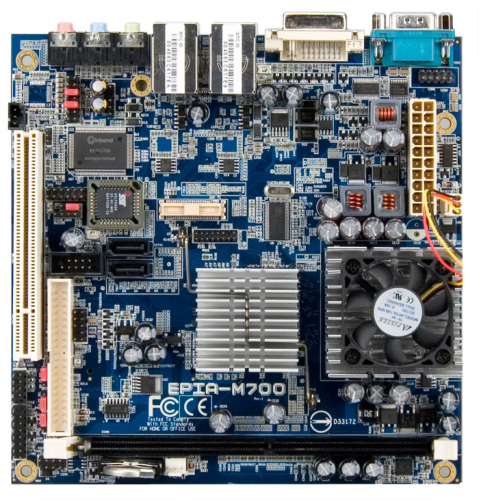Mini-ITX board signs up for new chipset
May 23, 2008 — by LinuxDevices Staff — from the LinuxDevices Archive — 1 views Via has announced a mini-ITX motherboard that combines the company's C7 processor and VX800 chipset. Targeting digital signage applications, the Epia M700 has dual gigabit Ethernet controllers, offers an array of video and audio interfaces, and includes a PCI expansion slot, says Via.
Via has announced a mini-ITX motherboard that combines the company's C7 processor and VX800 chipset. Targeting digital signage applications, the Epia M700 has dual gigabit Ethernet controllers, offers an array of video and audio interfaces, and includes a PCI expansion slot, says Via.
(Click here for a larger view of Via's Epia M700)
Via says the Epia M700 is its first board to use the VX800 chipset it announced last month. The VX800 combines northbridge and southbridge functions in a 33 x 33 mm package. It includes Via's Chrome9 2D/3D graphics engine, with DirectX 9 compatibility, hardware rotation capability, and the potential for a frame buffer as large as 256MB.

A block diagram of Via's Epia M700
(Click to enlarge)
The Epia M700 uses Via's C7 processor, and is available in a 1.0GHz version that can run fanlessly, or a 1.5GHz configuration that does require active cooling. The board accepts up to 2GB of 533MHz or 667MHz DDR2 RAM, in a single DIMM socket. As for mass storage, this can be provided via the included Type I CompactFlash connector, the 44-pin IDE connector, or one of two SATA connectors.

Via's Epia M700
(Click to enlarge)
Noting that “speedy server connectivity is becoming increasingly important in dynamic digital signage and kiosk solutions,” Via has fitted the board with dual gigabit Ethernet ports, both available via connectors at the board's edge. Other “real world” connectors, as shown in the picture below, include a serial port, a DVI video output, four USB ports, line in/out connectors, and a microphone input.

The Via Epia M700's “real world” I/O
(Click to enlarge)
As suggested earlier, the board also has additional audio and video interfaces. For example, its pin headers accept digital video input and output, provide 5:1 surround sound via S/PDIF, and can be used to extend additional audio inputs or outputs to the front panel of whatever device the board gets integrated into.
Headers also give the board two additional USB ports and a second serial port. If 802.11b/g wireless networking is desired, this can be added internally via USB.
Of course, the Epia M700 also has an ATX-style power connector, plus headers that can be used to connect both CPU and system fans. Its system monitor and management capabilities include CPU voltage and system temperature monitoring, fan speed detection, wake-on LAN, keyboard power-on, timer power-on, and a watchdog timer.
Features and specifications listed by Via for the Epia M700 include:
- Processor — Via C7 running at 1.5GHz or 1.0GHz
- Memory — up to 2GB of 533/667MHz DDR2 RAM
- Networking — 2 x gigabit Ethernet (back panel)
- Other I/O:
- Back panel:
- 1 x serial
- DVI
- 4 x USB 2.0
- audio line out, line in, mic in
- 1 x serial
- Headers:
- 2 x USB 2.0
- 1 x serial
- 2 x SATA
- 1 x IDE
- audio header for front-panel headphone out, mic in, or amplifier module
- S/PDIF output
- digital video input/output
- SPI
- PS/2 keyboard/mouse interface
- IrDA
- 2 x USB 2.0
- Back panel:
- Expansion:
- 1 x CompactFlash Type I
- 1 x PCI
- 1 x CompactFlash Type I
- Operating temperature — 0 to 50 deg. C
The Epia M700 runs Linux, Windows CE, Windows XP Embedded, and Windows XP Professional, according to Via. The company did not release pricing, but said the board will be sampling in June.
This article was originally published on LinuxDevices.com and has been donated to the open source community by QuinStreet Inc. Please visit LinuxToday.com for up-to-date news and articles about Linux and open source.